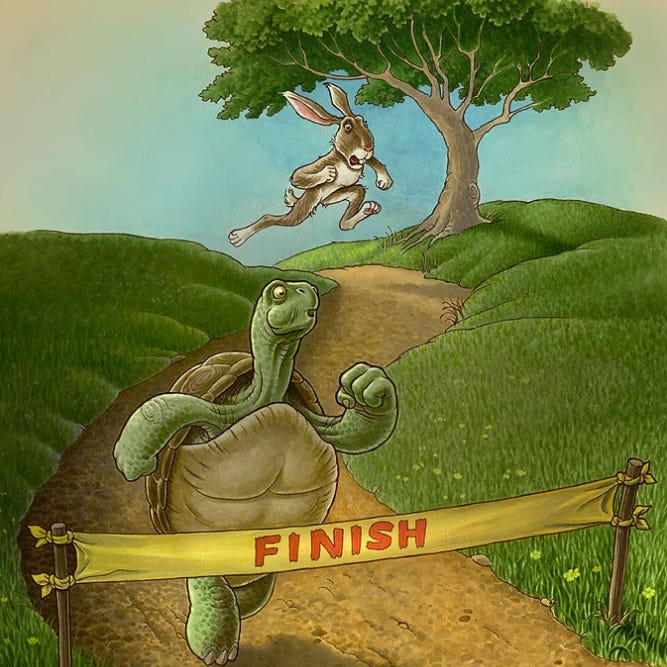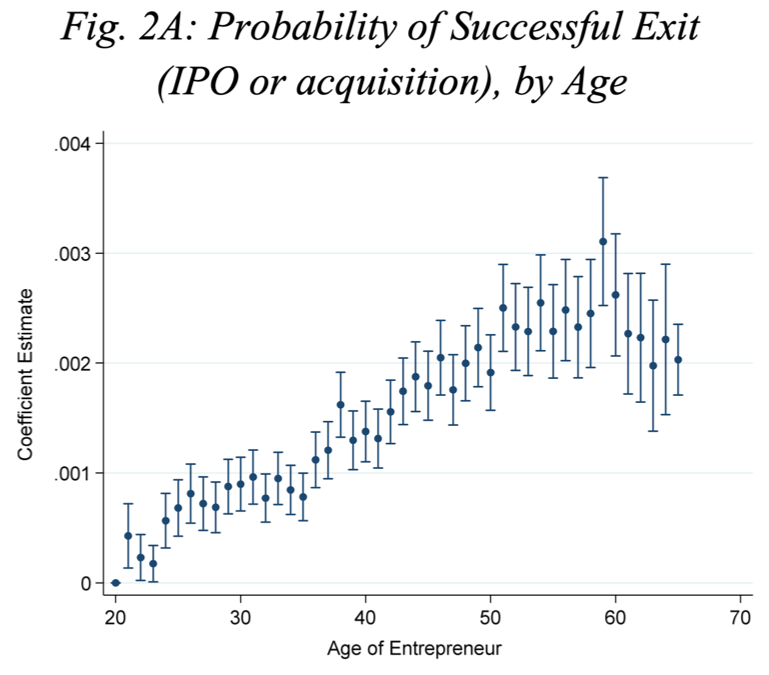When To Go Full Time With Your Side Hustle
Hot Take: If you're below 45 years old... don't quit your day job.
Hybrid Entrepreneurship
In 2014, Joseph Raffiee and Jie Feng, two researchers from the University of Wisconsin set out to answer one question:
Does starting a business while keeping a day job provide advantages compared to quitting a job outright to become a full-time entrepreneur?
They used the National Longitudinal Survey of Youth—a massive government dataset—that tracks people’s work history over time. After crunching the numbers, this is what they discovered:
Hybrid entrepreneurs were 33% less likely to exit their business compared to those who entered full-time self-employment directly.
Individuals who transitioned from hybrid entrepreneurship to full-time self-employment were 38 times more likely to stay in business than those who jumped straight into full-time entrepreneurship.
A one-year increase in hybrid entrepreneurship reduced the likelihood of business failure by 2.5%.1
Their findings suggest that hybrid entrepreneurs who later transition into full-time self-employment have significantly higher survival rates than those who enter directly from paid employment, largely due to the learning and experience gained during the hybrid phase.
This staged approach allows entrepreneurs to assess the viability of their business and develop the necessary skills before fully committing, with prior entrepreneurial experience further enhancing the survival advantage.
Don’t Quit Your Day Job… Yet
Before you dive head first into a side hustle by quitting your day job, ask yourself whether there’s a safer way to approach this. Paradoxically, the research shows that the safer you play your cards in your entrepreneurial venture, the more likely you are to succeed.
The research study was entirely focused on the impact of quitting your day job in stages, but there are many practical ways to begin getting into entrepreneurship without taking unnecessary risk.
Perhaps you can:
Validate your value hypothesis first by getting 5 paying customers.
Go part-time, instead of full-time out of the gate after getting your first few customers.
Put in 10,000 hours until you’ve mastered your craft then focus on making money.
Wait until you’ve made 60% of your day job’s income with your side hustle then go all in.2
The key is to be strategic about when you jump full time into a side hustle. Many people, myself included, often feel fear FOMO at the idea of not going all in. Influencers everywhere can make it feel like we need to quit our day job, and work from our laptop in Bali to have truly made it.
But the real ones who’ve put in 10,000 hours know that it just takes repetition, constant improvement, and consistency to be successful.
Slow and Steady Wins the Race
In the proverbial story of the tortoise and the hare, the hare loses the race because the he had the overconfidence to take a nap at the start of the race. Meanwhile, the slower tortoise instead chugged along, slowly but consistently the whole time. Eventually, he wins the race, a massive upset for the ages that all the farm animals probably talked about over beers for years to come.

And yet the narrative of the ultra-successful young founder doesn’t match reality. A recent study proved that the belief that young entrepreneurs are more successful is a myth.
Older Founders Are More Successful
In 2019, Pierre Azoulay, Benjamin Jones, Danny Kim, and Javier Miranda conducted a study to challenge the belief that young entrepreneurs are more successful. Some theories suggest young people have advantages like sharper cognitive ability and fewer responsibilities—i.e. no mortgage, wife, kids to take care of. After analyzing data from over 2.7 million founders from 2007-2014, the results shocked even me:
The mean age of founders of top 0.1% fastest-growing startups is 45 years old.
A 50-year-old founder is nearly twice as likely to achieve a massive success than a 30-year-old.
Founders in their early 20s have the lowest likelihood of successful exit via acquisition or IPO.

So what’s the takeaway here? Startup success comes with time. Older entrepreneurs possess greater human, social, and financial capital, which can outweigh the hustle and sweat equity youthful advantages.3 If you aspire to eventually be an entrepreneur, a good rule of thumb would be to work a day job in the industry that you wish to enter into with a startup.
The study also found that industry experience matters, too. Founders with at least three years of experience in the industry of their startup doubled their chance of a successful exit. I’m in my late 20s. The moral of the story I take away from this study is to:
Continue to put full effort into my 9-5 job, to grow my human, social, and financial capital.
Spend at least 3 years working a 9-5 job in the industry I eventually desire to start a company in.
There’s a final, but less talked about benefit to building a business on the side during the hours of 5-9: the forced constraint of building a profitable business with—at most—4 hours per day.
Parkinson’s Law
In 1955, Cyril Parkinson, a British naval historian who worked in military and government during and after World War II. His work as a historian and scholar gave him a unique perspective about the inefficiencies of Britain’s bureaucratic government system.
Even when organizations had less work to do, their staff numbers continued to grow. The British Admiralty and Colonial Office showed that bureaucratic staff increased despite reductions in responsibility.
The British Navy had fewer ships and sailors after World War I, but the number of administrators rose sharply.
His analysis showed a consistent 5.17% to 6.56% annual increase in administrative staff, regardless of workload changes.
He found similar trends in different organizations, reinforcing his conclusion that bureaucracy tends to self-perpetuate.4
The essay was written satirically, but has since became widely recognized as a principle of organizational—and personal—inefficiency.
Time Is Your Greatest Asset
"I can buy anything I want, basically, but I can't buy time" — Warren Buffett
Translated into personal productivity terms, Parkinson’s Law means that work expands or contracts to the time allotted for its completion. The forced scarcity of building a project on the side is your friend. Put another way, “necessity is the mother of invention.”5
Rather than viewing your 9-5 job as a burden, realize that it’s forcing you to be more efficient with your time, setting you up for a better lifestyle when it is time to take the leap full-time into your side hustle. Artificial scarcity is good because it forces you to identify new ways to efficiently get results.
Moral of the story: Don’t quit your day job… yet. Patience, strategy, and persistence are the true markers of entrepreneurial success—so don’t rush the race before you’re ready.
— Grant Varner
Raffiee, J., & Feng, J. (2014). Should I Quit My Day Job? A Hybrid Path to Entrepreneurship. Academy of Management Journal, 57(4), 936-963. Link.
‘Thank You’ to Justin Welsh for the idea of waiting until you've replaced 60% of your income before going all-in on your startup. He has discussed this concept extensively, and credit goes to him for this benchmark. Source.
Azoulay, P., Jones, B. F., Kim, J. D., & Miranda, J. (2019). Age and high-growth entrepreneurship. Retrieved from Link.
Parkinson, Cyril Northcote. “Parkinson’s Law.” The Economist, 1955. In this essay, Parkinson introduced the concept that “work expands to fill the time available for its completion,” now known as Parkinson’s Law. Retrieved from Link.
According to Phrase Finder: “The author of this proverbial saying isn’t known. It is sometimes ascribed to Plato and it does appear in translations of Plato’s Republic.”




Interesting article, where usually the focus is on going fully in for starting up a company. But this is more realistic and good to know it’s never late to start one.